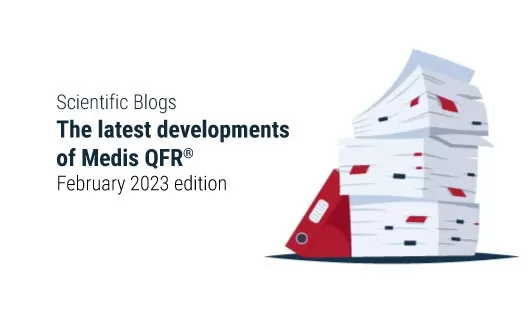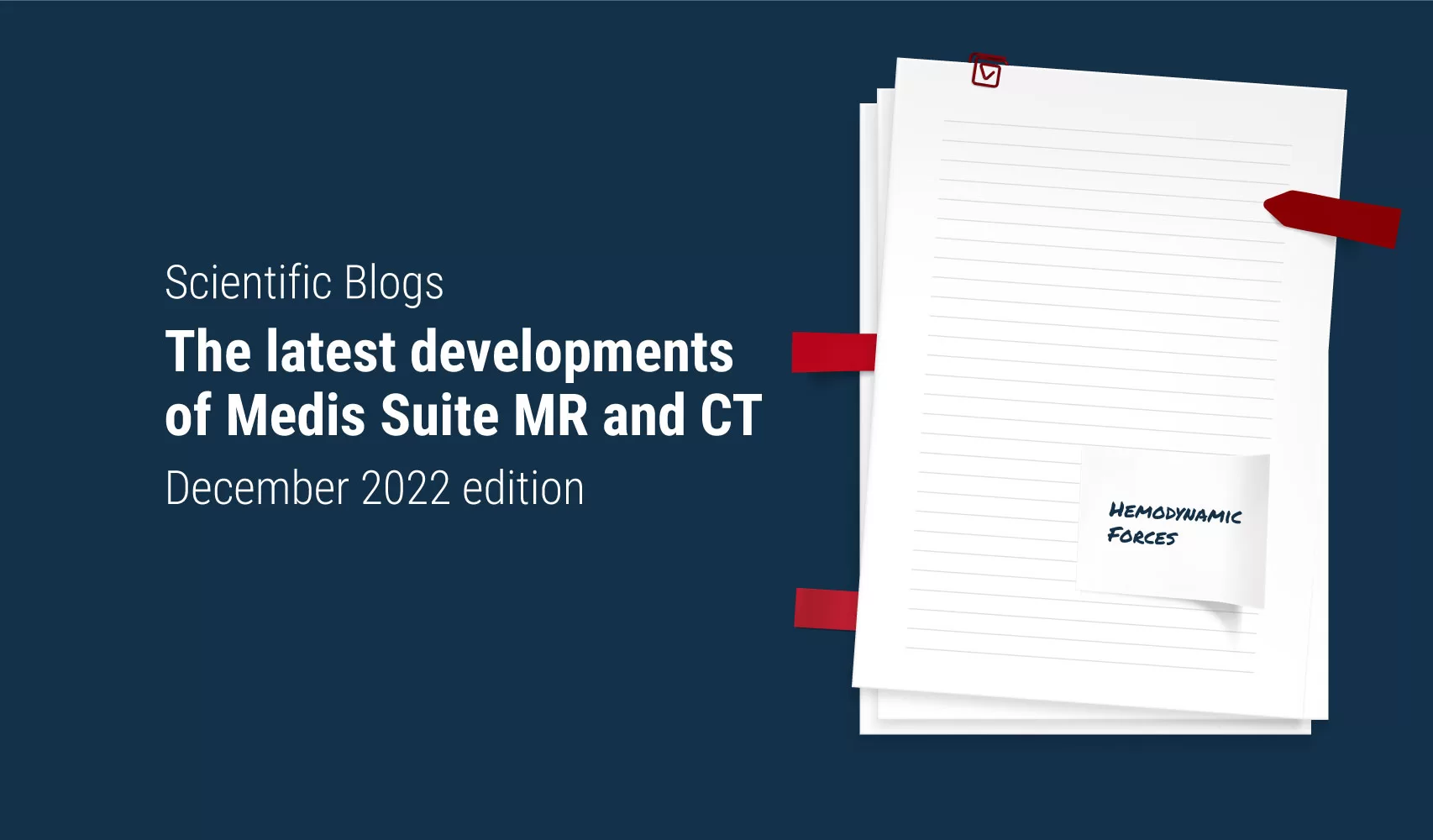Scientific Blogs
The latest developments of Medis QFR®
March 2023 edition
10 mins – March 24, 2023 – Written by Prof. Hans Reiber
Given the regular posts of peer-reviewed scientific publications on the developments of Medis QFR ®, it is clear that this angio-based solution for coronary physiology is extensively used in clinical research and practice. We would like to share these publications with you so that you remain up to date about the research that is ongoing worldwide with this innovative solution, whereby each time new clinical applications are being tested, validated and tried out in particular populations. With its non-invasive nature, readily available, and broad applicability, we anticipate a significant growth in its usage, supported by our constant quest for further automation.
In this new Medis QFR® blog, we are proud to share four publications on the latest developments of Medis QFR with you.
Angiography-derived index of microvascular resistance in takotsubo syndrome
Dr. G. Castaldi and co-authors under the supervision of Dr. F.l. Ribichini from the University of Verona in Italy published this paper in the Int. J. Cardiovascular Imaging. This is a retrospective study of 41 consecutive patients with takotsubo syndrome (TTS). Three indices of angio-based IMR, all based on Medis’ QFR were compared and correlated with clinical presentations; threshold IMRangio was ≥25 units. They found that coronary microvascular dysfunction assessed with angio-derived IMR is a common finding in TTS and is inversely correlated with LV function. Also, the available formulas have a substantial superimposable diagnostic performance in assessing coronary microvascular function.
For further read: click here
QFR-based virtual PCI or conventional angiography to guide PCI; the AQVA trial
Dr. S. Biscaglia and co-authors under the supervision of Prof. G. Campo from Ferrrara University Medical Center in Ferrara, Italy published a very interesting paper in JACC Interventions. This is a prospective trial in 300 patients and 356 study vessels undergoing PCI and randomized to receive either QFR-base virtual PCI or angiography-based PCI (standard of care). Primary outcome was the rate of vessels with a suboptimal post-PCI QFR result, defined as < 0.90. The primary outcome occurred significantly more frequently in the angiography-group (n=26, 15.1%) compared with the QFR-based group (n=12, 6.6%). The authors concluded that the AQVA trial demonstrated the superiority of QFR-based virtual PCI over angiography-based PCI with regards to post-PCI optimal physiological results.
For further read: click here
Quantitative flow ratio versus fractional flow reserve for guiding percutaneous coronary intervention: design and rationale of the randomized FAVOR III Europe Japan Trial.
Dr. B.G. Andersen and co-authors under the leadership of Dr. E.H. Christiansen and Dr. N.R. Holm published in the January issue of EuroIntervention the Design and Rationale of the FAVOR III Europe Japan Outcome trial for the Medis QFR. For further read: click hereInterested in the developments of Medis QFR ®?
Easily request a demo of our innovative software solution
Request a demoQuantitative Flow Ratio vs. Angiography-only guided PCI in STEMI patients: one-year cardiovascular outcomes.
Dr. M. Barauskas and co-authors under the leadership of dr. R Unikas from the department of cardiology at the hospital of Lithuanian University of Health Sciences in Kaunas, Lithuania published a very interesting paper in BMC Cardiovascualr Disorders. This is a prospective, single-center study including 198 patients admitted with STEMI, who were randomly assigned to QFR-guided PCI or visual estimation-guided PCI with a 12 months FU. Survival analysis proved that patients in the angio-group had a more than 6-fold greater risk for death within a 12 months period after MI, with the highest mortality risk within the first 2 months after initial treatment. The authors concluded that using QFR in non-culprit lesions in STEMI patients reduces mortality and revascularization at the 12 months FU and improves the quality of life of the patient.
For further read: click here
In the beginning there was angina pectoris, at the end there was still angina pectoris.
The Editorial Comment by P.W. Serruys et al in JACC Interventions, refers to the paper by Collet on focal and diffuse disease (JACC Intv; 2022; 15(24):2506-2518). Serruys discusses the complex evaluation of Pre-PCI (PPGindex, dQFR/ds) and Post-PCI (QFR and IMR). It becomes more and more important to quantitatively assess the extend of focal and diffuse disease pre-PCI, to determine what the proper treatment strategy should be, and to assess the results post-PCI both in terms of the remaining pressure drop (QFR), as well as the microcirculatory index (IMR).
For further read: click here
Rationale and design of the iCORONARY trial: improving the cost-effectiveness of coronary artery disease diagnosis
Dr. J. Peper and co-authors under the supervision of Dr. M.J. Swaans of the St Antonius hospital, Nieuwegein, The Netherlands published the Design of the iCORONARY trial in the Netherlands Heart Journal. This is a Dutch prospective, multicentre, non-inferiority randomized controlled trial (RCT), with a blinded end-point evaluation. It investigates the costs, effects and outcomes of different diagnostic strategies to evaluate the presence of CAD and the need the revascularization. The study consists of 3 randomized groups: 1) FFR-CT guided strategy, 2) QFR-guided strategy, or 3) standard of care. The primary endpoint will be MACE at 1 year.
For further read: click here
Diagnostic performance of quantitative flow ratio, non-hyperaemic pressure indices and fractional flow reserve for the assessment of coronary lesions in severe aortic stenosis.
Dr. C. Dowling et al from the Monash Health and Cardiovascular Research Center, Melbourne, Australia published a paper in Cardiovascular Diagnostics and Therapy under the supervision of Dr. Dennis Wong. This is a prospective study of 35 patients who were considered for TAVI. The key findings of this study are: 1) QFR demonstrates excellent discriminatory power and good diagnostic performance (AuC > 0.92) for predicting functionally significant FFR in the setting of severe aortic stenosis; 2) QFR demonstrates an acceptable diagnostic performance (AuC > 0.90) relative to non-hyperemic indices (iFR, dPR and pd/PA); and 3) QFR demonstrates excellent diagnostic performance (AuC=0.93) vs FFR when QFR values are outside the borderline zone of 0.75-0.85.
For further read: click here
Share this article on:
Related articles

The latest developments of Medis QFR®
February 2023 edition

The latest developments of Medis Suite MR and CT
December 2023 edition

The latest developments of Medis QFR®
January 2023 edition
